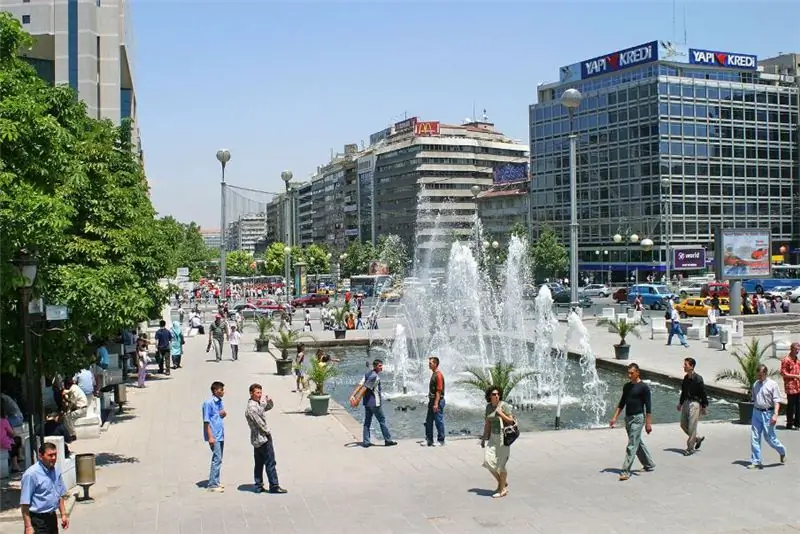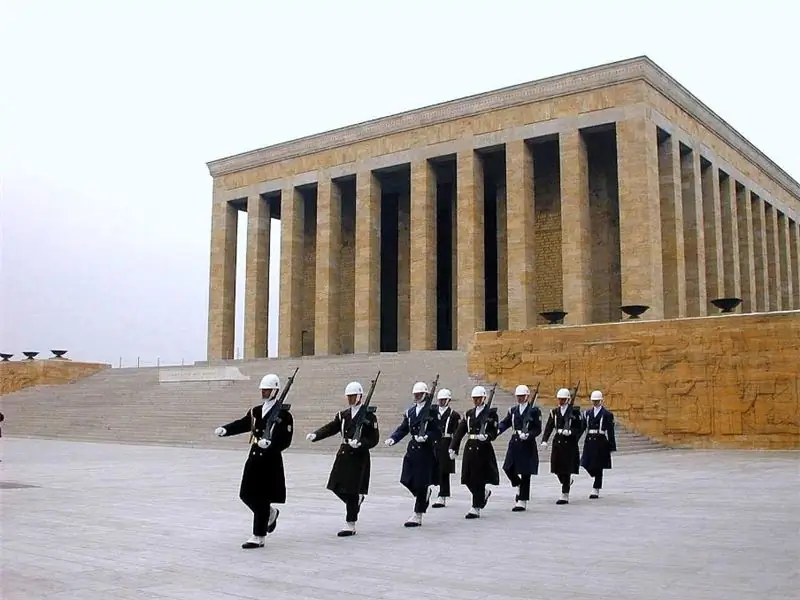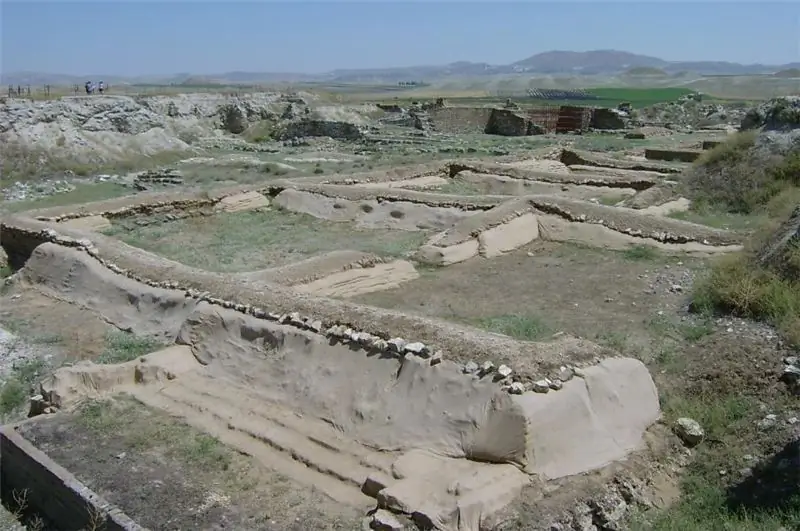
It is generally accepted that there is not much to do in the capital of Turkey. There are no beaches and all-inclusive resort hotels here, the vibrant life is in full swing in Istanbul on the shores of the Bosphorus, and there are more than 700 km to the cave cities of Cappadocia and several changes. And yet, once in Ankara, you can spend your time exciting and unforgettable, because the Turkish capital is one of the oldest cities in the Asia Minor peninsula.
Located at the crossroads of trade routes, it flourished already in the 7th century. BC NS. under the Greek name Angira. Then, in the life of the current Turkish capital, there were the Byzantines and Seljuks, the crusaders and again the Turks, each conqueror reshaped the city and the world in a new way, and therefore there is something to see here. Ankara will undoubtedly appeal to lovers of medieval buildings, and fans of museum expositions, and those who like to wander through the old streets with a camera in their hands and shoot life as it is.
TOP 10 attractions of Ankara
Anitkabir

The founder of the Turkish Republic and its first president is a respected person in the country. His tomb in Ankara was built as a sign of the deep respect of the Turks for the man who gave them freedom and a better life.
The mausoleum of Mustafa Kemal Ataturk was founded in 1944. The work took almost nine years, and as a result, the project of local architects Emin Khalid Onat and Ahmed Orhan Arda was embodied in stone.
The building looks very majestic. The total area of the complex, which includes the tomb itself, a museum at the mausoleum, a park and outbuildings, is 750 hectares. The architects provided for four parts of the mausoleum complex: the Hall of Fame, Ceremonial Square, Peace Park and the Lviv Road.
Foreign tourists are especially fond of the collection of cars that the first president of the Republic of Turkey drove. It is exhibited in the museum of the Anitkabir complex. Visitors are also impressed by the ceremony of changing the guard of honor. Soldiers change around the clock every hour.
Ataturk Museum and the War of Independence
The museum on the territory of the Anitkabir mausoleum is dedicated to the war of independence and the personal contribution of Kemal Ataturk to the liberation of the people from foreign intervention. The hostilities began in 1919, when the Greek army occupied Izmir, and continued until the signing of a peace treaty in 1923 in Lausanne. After the end of the war, Mustafa Kemal took the name "Ataturk" and became the first president of the new state.
The museum was opened in 2002 and has become one of the popular points of the excursion program for guests of Ankara. On the stands, you can look at the personal belongings of the first president, get acquainted with the progress of the Dardanelles operation depicted on dioramas, imagine the Battle of Sakarya and the Great Offensive, and feel the atmosphere of battles conveyed by sound and video effects.
The museum displays the personal library of Kamal Ataturk, numbering more than three thousand volumes.
Museum of Anatolian Civilizations
One of the richest in the world, this metropolitan museum attracts anyone interested in archeology, history and ancient civilizations to Turkey. It was founded in 1921. Under the patronage of Kemal Ataturk himself, the collection was rapidly replenished with new exhibits. The first president of Turkey studied the history of the Hittites who inhabited Asia Minor in the XIX-XII centuries. BC NS. The powerful Hittite state left a lot of evidence of its existence and development, to which the exposition of the Museum of Anatolian Civilizations is dedicated.
In addition to the treasures found in the land of Asia Minor, the collection contains the most valuable archaeological exhibits from the Neolithic and Bronze Age of the kingdoms of Urartu and Assyria, the civilizations of Ancient Rome and Greece, the Ottoman Empire and Byzantium.
Atakule Tower
Despite the fact that the Atakule Tower appeared in the Turkish capital only at the end of the twentieth century, it quickly became a city attraction, popular with tourists. Hundreds of people climb the 125-meter Atakule from a bird's eye view of Ankara.
Ankara TV Tower, like the communication towers of other cities in the world, has several entertainment venues:
- From the outdoor terrace, you can admire the views of the city and take a selfie at a bird's eye view.
- In the Sevilla restaurant you can (see the name) not only order lunch in traditional Spanish style, but also make a complete revolution around the Atakule axis. The restaurant rotates slowly, and diners enjoy not only changing dishes, but changing views outside the window.
- The landscape does not change in the Kupol restaurant, but it is one level higher than the Sevilla, and a particularly breathtaking view of Ankara at night opens from its windows.
- In a cafe called UFO, the dishes are quite ordinary, and not flying at all. But the views from the windows can compete with the view in the plane's window upon landing.
Visitors are lifted to the top of Atakule by an elevator that covers 125 m in just 46 seconds.
Gordion

90 km from Ankara, you can look at the ruins of the city of Gordion, the former ancient capital of Phrygia. It was located on the right bank of the Sangaria River, near its confluence with the Porsuk River.
Historians believe that the city was founded by Gordius, who was the first Phrygian king in the 8th century. BC NS. Excavations begun in the first half of the last century made it possible to discover defensive walls made of raw bricks and stone and allowing to repel enemy attacks, residential buildings and a necropolis, whose burial places enriched the exposition of the local archaeological museum.
During the excavations, many tools, household items and weapons were found dating from about the 8th-5th centuries. BC.
The main treasure found in Gordion is mosaics made from rough pebbles. Researchers consider the mosaic floors of the Phrygian capital to be among the first examples of such a technique found. The largest mosaic is 10x11 m in size and dates from the 8th-5th centuries. BC NS. When creating it, the master used river stones of different colors.
Ankara Castle
The fortress of the Turkish capital was laid by the Galatians on a natural foundation formed by lava deposits. The construction was completed by the Romans, and the Seljuks who came in the 11th century rebuilt the fortifications according to their own taste.
The castle consists of two defensive lines. The inner one surrounds with powerful walls an area of 350 sq. m. At a distance of 40 m. from the first ring, a second line of walls with towers was built.
The oldest part of Ankara, the fortress is a fine example of traditional Turkish fortification architecture.
Roman baths
The ruins of ancient Roman baths were discovered during archaeological excavations in the 30s and 40s of the last century. They are located on a plateau in the center of Ankara's old district called Ulus.
In ancient times, Ankara stood at the crossroads of trade, military and political routes and was part of the Roman Empire. The ancient Romans were known for their love of bath complexes, and in any city that was at least a little in their possession, archaeologists find baths.
The Baths of Ankara were built by Emperor Caracalla in the 3rd century. You can look at the three branches of the once luxurious bath complex - the hot water caldarium, the tepidarium, which housed the warm baths, and the frigidarium, a place for cold baths. The excavation area is about 9, 5 hectares. The theory that the baths appeared during the reign of Caracalla is confirmed by the found coins with his image.
State Museum of Fine Arts and Sculpture
The richest collection of Turkish art is kept in the Ankara State Museum. In its halls you will find paintings and sculptures, ceramics and rare photographs, which are of particular value for history and have been carefully collected since the beginning of the 20th century.
The exposition was opened in 1930 by Kamal Ataturk, who, being an educated person, paid great attention to the preservation of historical traditions and the education of his fellow citizens.
The mansion where the exhibits are located is decorated in the Turkish national style. The interiors are decorated with rosewood plates.
The main treasures of the museum are paintings by Osman Hamdi-bai, Zonaro, Emel Koruturk and "The Door of Timur Tamerlane" by Vasily Vereshchagin.
Kocatepe Mosque

The largest mosque in the Turkish capital was built quite recently, but it is of considerable architectural value. Initially, the city authorities decided to build a mosque in accordance with modern building traditions, but then they still preferred the classic project of Vedat Dalokaya. The architect supervised the construction, which began in 1967 and lasted for two decades:
- The total area of the building is 4288 sq. m.
- The mosque is crowned with a large dome, the diameter of which is 25.5 m, and the height exceeds 48 m.
- Four minarets at the corners of the building rise 88 meters each. The towers are decorated with gilded crescents.
The interiors of the main mosque of Ankara are not inferior to the medieval Istanbul ones. The interior space is decorated with colored stained glass windows and mosaics made of gold plates, marble and hand-painted tiles.
Wonderland ankara
When arriving in Ankara with children, plan a visit to the Wonderland Ankara amusement park, which is very popular with residents and visitors alike.
Opened in 2004, the park offers a classic set of activities and attractions to have a great time. You will find minigolf and roller coasters, go-kart tracks and rails for skateboarders, basketball courts and tennis courts, the land of Gulliver and Lilliputians and other fabulous locations in Ankara's Wonderland.
The amphitheater, which seats 5,000 spectators, often hosts performances by magicians, pop performers and theatrical performances.






